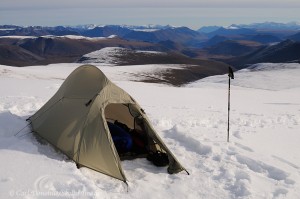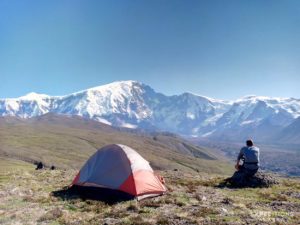
Hey folks
A lot of people planning their Alaska backpacking trip inquire about the “best” sleeping bag to bring; i.e., what temperature rating to bring. My recommendation has always been for a warmer bag than many people typically expect. My advice for a summer bag in Alaska is 20deg F, (about -6deg C) and no warmer.
That is,
Surely it’s not going to be below freezing in July, I hear folks respond?
Well, hopefully not. But it certainly can be, especially if we hike up in the high country at all (which we typically do, because that’s where the views are, and where the brush isn’t). And the altitude needn’t be that high; 5000 feet is alpine country in Alaska.
But the reasons for a warm bag go beyond merely snow and cold. Some folks will say they’d rather bring a warmer bag, like a 32deg F bag, as it’s lighter weight, and they can always wear extra clothes to bed if need be. They’ll be bringing warm clothes along anyway, right? Sometimes, this is true. But there can easily be times when it is not true. How about your fleece jacket is wet? Or you lose it (yes, I’ve seen that happen)?
It matters not, in my opinion, how often this might happen. It matters more that you’ll be cold without it. I simply don’t ascribe to the view that cutting weight is everything in the backcountry. Staying warm and sheltered is #1.
On a weeklong trip to the backcountry in Alaska, you can’t simply hike out if the weather’s cold; especially if you do a fly-in trip. On a remote journey in to the wilderness, your sleeping bag is your last refuge against the cold. It’s the most shelter you can expect to have. I don’t want to be squirming around in my bag trying to find that warm sport, and wriggling my toes because they’re chilly. I don’t want to lose sleep because I couldn’t QUITE get comfortable.
What I do want to do, even if it’s blowing a blizzard outside, is hunker down inside my tent, batten down the hatches, crawl inside my sleeping bag, and sleep soundly. If my last pair of socks got soaked thru on the hike, I don’t want to rely on them for my comfort at night. That’s the job of my sleeping bag, and my socks, my down jacket, my fleece hat, etc are there in case that’s not available. Those are the backups for emergency situations. My sleeping bag is not an item I’ll quibble over a few ounces about.
Some people feel the cold far, far more than others; often women feel the cold much more than men do (or at least than men they do). 🙂 If you’re one of those people who feel the cold, you could easily be cold sitting around camp in your fleece and down clothes, your hat and gloves, and that sleeping bag is where you head to be cozy. Bring one that is up the job. My advice is to go for 20deg Fahrenheit, at most … and don’t shy away from a 10 or 15deg bag, or even lower. I’ve seen people bring a minus 10deg bag on a trip, and be glad they did.
Your sleeping pad makes a big difference as well. I’ll write about that another time. Just be sure your bag is up to the task.
Be warm, sleep well, and enjoy the night, for tomorrow you could be wet and cold all day long. 🙂
Cheers
Carl



